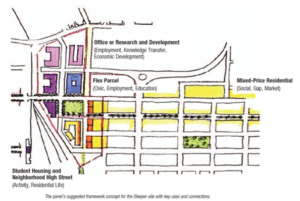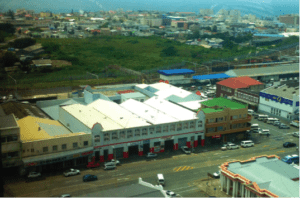Top Story
PANELS FOR SOUTH AFRICAN CITIES
The ULI Advisory Services program has conducted a series of panels in the Republic of South Africa. These panels have been conducted at the request of the World Bank in cooperation with the National Treasury of South Africa. These panels are provided to the National Treasury and to participating metropolitan areas that draw on the World Bank’s global experience and network of urban experts. The National Treasury’s Cities’ Support Programme (CSP) is a unit within the National Treasury that provides technical assistance to cities in South Africa. That assistance is aimed at helping cities manage the built environment in a way that promotes economic growth, job creation, access to basic services, environmental sustainability, and public accountability.
Buffalo City, South Africa
Date: December 7–10, 2014
Location: Buffalo City, South Africa
Sponsor: The World Bank and the South African National Treasury
Subject Area: Revitalization of Warwick Junction
Panel Chair: Gary Hack, Professor Emeritus of City and Regional Planning, University of Pennsylvania School of Design, Philadelphia, Pennsylvania
Download Full Report
Background and Panel Assignment
 The amalgamation of East London and its surrounding towns and cities into the new municipality of Buffalo City offers an opportunity to rethink how the city is viewed by South Africans and the wider international community. The city’s central business district (CBD) is critical to the new identity: it is the point of reference for people using and visiting the city. Its attractiveness as both a place to visit and a center of economic activity will determine how effective Buffalo City will be in attracting and retaining new businesses and employees, especially the highly skilled workforce needed for the services of the future. The municipality’s acquisition of the Sleeper site represents one of the most important opportunities to rechart the course of the CBD.
The amalgamation of East London and its surrounding towns and cities into the new municipality of Buffalo City offers an opportunity to rethink how the city is viewed by South Africans and the wider international community. The city’s central business district (CBD) is critical to the new identity: it is the point of reference for people using and visiting the city. Its attractiveness as both a place to visit and a center of economic activity will determine how effective Buffalo City will be in attracting and retaining new businesses and employees, especially the highly skilled workforce needed for the services of the future. The municipality’s acquisition of the Sleeper site represents one of the most important opportunities to rechart the course of the CBD.
The Sleeper site, 13.6 hectares (33.6 ac) of undeveloped land, presents both an opportunity for and a challenge to the future development of the city center. Located just east of the East London Railway Station, it forms a barrier between the CBD and the residential districts to the northeast (Quigney) and the southeast (central beachfront).
The ULI panel was asked to address three issues concerning the highest and best uses for the Sleeper site:
 What catalytic projects could best unlock investment in the area without privatizing public assets?
What catalytic projects could best unlock investment in the area without privatizing public assets?- What are practical suggestions for making connections between the Sleeper site and its surroundings?
- How can the Buffalo City Metropolitan Municipality (BCMM) strengthen urban management within the greater CBD, Sleeper site, and central beachfront area so that they become recognized?
- What are the likely impacts (positive or negative) on the CBD and surrounding areas if a consolidated civic center is developed on the Sleeper site?
- What are the likely costs and benefits of developing an extended inner-city university campus within the Sleeper site and the East London CBD?
Summary of Recommendations
The ULI panel’s conclusions can be summarized as follows:
- Make revitalizing the CBD the prime objective; both Oxford Street and the Sleeper site have key roles to play. The development strategies for the two areas must be complementary. It does little good to transplant uses from Oxford Street to the Sleeper site: while the Sleeper site would develop, Oxford Street would decline. Rather, the objective must be to increase the overall number of people coming to the CBD and to plant the seeds for an expanded economy.
- Improve both the quality of the public realm and the safety of Oxford Street as a critical first step. Steps should include (a) basics such as cleanliness and improved safety and a perception of personal safety, (b) expanded and improved pedestrian areas, (c) better pedestrian crossings, (d) better lighting and landscaping, (e) rationalized lanes for minibuses and public transit, and (f) a reduction of travel lanes for automobiles and especially for trucks.
- Create a civic center at the north end of Oxford Street and expand university activities at the south end.
- Recognize development of the Sleeper site as an opportunity to stimulate the economy of Buffalo City. A high-quality university can be one of the most effective engines of economic development, attracting and developing talent that will be desirable for high-skill industries.
- Focus the Sleeper site on the knowledge-based and creative economy, creating a live/work/learn environment. The city’s future economy depends on training and retaining highly skilled workers capable of creating and attracting businesses not yet in the area. A specific focus should be made to engage the University of Fort Hare (UFH) as a catalyst for new public and private investment.
- Establish a suitable physical framework within the Sleeper site and maintain flexibility for new types of development. The site needs to be effectively connected to the existing CBD and the waterfront, the two critical areas that will benefit from its development. The volume of train traffic is low enough that a signalized at-grade crossing to the CBD should be possible at Buxton Street, while transforming Moore Street into a boulevard to the sea will make the waterfront easily accessible.
- Create an independent, business-oriented, self-financing entity to oversee development of the Sleeper site, and the CBD. The CBD will also require a separate commercial improvement district (CID) to oversee the transformation of streetscapes (“crime and grime”) and to manage maintenance activities and promotion of the CBD. Those functions are sufficiently different from those required for the Sleeper site that separate entities, each highly focused, are justified.
